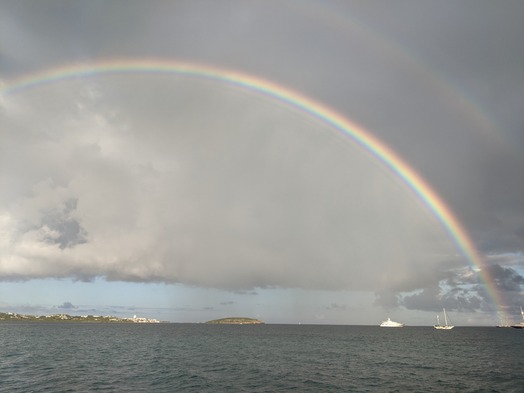When we first purchased Wild Rose we left her at a mooring ball in St. Maarten. This mooring was specifically installed for her, and was much more reasonable than paying marina fees.
Nowadays I really only moor my boat as a last resort, I prefer to anchor. The reason for this is simple, I know I have great anchor tackle. I have a great anchor, well cared for chain and an excellent snubber. I trust my anchor tackle infinitely more than any mooring.
However, mooring fields are becoming more and more common and if you haven’t had to tie to a mooring yet, you eventually will. Many countries have installed multitudes of moorings, in my opinion, as a money maker. Some have installed them in marine sanctuaries so no one is anchoring on the sea floor allowing sea grass and coral to flourish. Sometimes very deep anchorages require mooring where anchoring would be prohibitive. For these and probably other reasons, many anchorages in the world are being replaced by mooring fields and we are all going to be tying up to moorings at least every once in a while as a result.
I’m not a particularly big fan of this, the mooring field operators assume no liability if their moorings break and your boat is damaged as a result. So, you get to pay for a potentially dangerous situation. I treat all moorings as suspect until I verify they are ok.
An example of a place that installs and maintains moorings properly is The British Virgin Islands. They have put in a lot of mooring fields because of the bareboat industry there. Their moorings are very well cared for.
In my experience the opposite of that is St. Lucia. I know the parks department has installed some, but I personally don’t think they are well cared for and would not tie up to them again. There are a lot of spotty moorings around the world.
Get Local Knowledge
Before you tie up to a mooring ball, it is best to get local knowledge from a cruising guide or online forum such as Navionics or the Cruisers Forum. You want to find out how well the moorings are maintained, quality of the mooring, what they are made from, etc. Basically you’re trying to determine if they are suitable or not. It is not in your interest to tie up to a dodgy mooring.
Know what type of mooring you are tying up to. Moorings have weight limits and depending how robust they are and how they are attached to the sea floor they may or may not be suitable for your boat. Additionally, some moorings are for overnight use, and some are for day use only. Some located in national parks require a special permit, and nearly all overnight moorings require a fee. For those requiring a fee, sometimes the operator will come around and collect the fee, some require you to go to land to pay. Some moorings come with showers, trash and other facilities although this is rare.
If you are paying for a mooring always get a receipts. It is not uncommon some parts of the world for someone to try to dupe you into paying them for a mooring that isn’t theirs. It’s nearly happened to me a couple of times.
What do you need to tie up to a mooring?
Line and a boat hook.
First, the type of line you use for mooring is important. If you are going to get any type of weather you want a rope that stretches. Nylon line stretches, polyester does not. So you if you have older halyards or sheets that are past their service life that you are looking to repurpose, do not use them for mooring.
All of my dock lines are nylon double braid, and these are the same lines I use for mooring. Three strand nylon line is good as well. I like the feel and pliability of double braid and eight plait much better than three-strand. After time, three-strand nylon gets harder and less pliable. But, if that’s all you have, it will be fine. The most important attribute is that it is nylon and not polyester.
You want the stretch because the line will act like a shock absorber between your boat and the sea floor. The mooring itself should be made of nylon or a combination of chain and nylon.
Now you are going to need two ropes, depending on the size of your boat, roughly 20 to 25 feet long.
Our boat is pretty high off the water at the bow, so we use a 9 foot long boat hook. Your boat hook needs to be long enough to get to the waterline plus an extra couple of feet to reach out a little bit.
Prep the Boat and Crew
Get out your mooring lines and the boat hook, get the lines ready by flaking them on the deck and tying one side of each line off to each bow cleat. Give your crew a briefing on what is going to transpire, the goal and their duties.
It is important for them to know that if something goes wrong you may abort the attempt, reposition the boat and try again. It’s also important for them to understand that having a line in the water not under control is a big issue as it can get caught in the propeller causing a big problem.
The Approach
You need to approach the mooring ball slowly from downwind. You want the wind directly on the bow, this makes maneuvering the boat easier keeping it pointed straight into the wind. You want to be going slow enough that the wind and water resistance slow your boat to nearly stopped when the bow gets to the mooring ball.
Upon your approach it helps to have the person at the bow call out the distance to the mooring as well as point to it with their arm or boat hook. It is difficult to judge the distance from back at the helm station and if you are pointed straight at it at some point you are going to lose sight of the ball from your position at the helm station.
You may need to put it into reverse once you get to the ball to put yourself in a stopped position. You need to allow the person at the bow time to pick up the pendant or ball and tie up to it. So you will need to keep the boat in position at least until the person at the bow can get at least one line through the mooring or pendant.
This is much more difficult in high winds and with current. Take your time, go slow and abort the attempt if you need to. Better to pull the boat around rather than hitting another boat, getting the mooring stuck in your prop or injuring someone.
Proper way to tie up
95% of the time it is just Nancy and I tying up to a mooring ball, so we have two people. Our boat is 25 feet wide, so pulling up the mooring and tying up is a bit of a feat for one person on the bow. It is much easier when we have crew. So, if you have crew utilize them by helping them handle lines or operating the boat hook.
The bow person will need to determine if there is a pendant, which is a floating line that trails from the mooring ball, usually about 6 feet long. Often there is no pendant, it is just a metal ring that comes through the mooring ball. The latter is sometimes more difficult to pull up and takes some more force.
Either way, the person at the bow will need to pull this up with the boat hook and get at least one mooring line through the tie off point. Then take that line back to the cleat where it originated from. Our boat is 25 feet wide, so getting both lines through the mooring tie off point and back to the cleats is very difficult. So we focus on getting one done so the boat is attached to the mooring, then we can use the engines to keep the boat in position while getting the other line attached.
Once you get both lines through the mooring, then you need to adjust them so they are the same length. On a monohull you want your boat to be trailing behind the mooring by a few feet.
Why Two Lines?
This is very important, there are a few of reasons to use two lines. First and foremost is so the line does not saw through the mooring tie off point. Often these are just rope, plastic or may have a chafing sleeve over them. If you only use a single line it can and will eventually saw through the mooring tie off point. This back and forth action over days, weeks and months will destroy the mooring.
Another reason is for redundancy. If one of your lines comes loose, chafes, or breaks, then you have the other as a backup. Check your mooring lines often.
Last, the two line system creates a bridal, and if you have each line the same length your boat should trail just behind the mooring. This keeps equal tension on both lines, preventing any chafing, and orients your boat directly down wind or down current from the mooring. It keeps your boat in the same orientation to the mooring as the rest of the boats in the mooring field.

Can I do This Solo?
Yes, absolutely you can tie up to a mooring solo. The most common method is to get the mooring ball to the side or even to the back of the boat and then once you get a line through it you can walk it forward. This is much easier with a small boat, but can still be done on larger vessels.
Determining the Quality of the Mooring
I pulled up to a mooring in St. Bartholemy and my crew picked up the pendant. I always inspect everything as the skipper, so I looked down and saw the pendant had some chafing, so we dropped it. I wasn’t going to trust a chafed mooring pendant to hold my 42 foot catamaran while I was sleeping or on the island. No way. I went to try to anchor and another mooring opened up, this one was in good shape so we tied up for the night.
Moorings can be old, chafed, nor properly secured to the sea floor, or any multitude of other problems. I once pulled up to a mooring in St. Lucia, and after tying up to it I backed down on it as is my usual procedure. That mooring didn’t hold for two seconds before it broke. No way I would have trusted that even for just a night.
Test the Mooring
Once you are tied up properly and satisified with your setup it’s time to test the mooring. Every boat is a little different, but I run both of my engines in reverse and gradually increase the RPM’s to 2200 until I am satisfied that the mooring will hold me in a blow.
Dive the Mooring if Possible
The other way to check the mooring is to dive on it. Often this is not possible if the water is murky or the mooring is deep. If possible I dive on any mooring we take just to ensure the attachment points and chain are in good condition.
Set your anchor alarm
Just because you are tied up to a mooring doesn’t mean you are safe for the night.
On several occasions I am aware of boats that tied up to moorings that were not tested and poorly maintained where it broke in the middle of the night and the boats wound up on a reef or shore. These boats were destroyed. This is why I prefer my own ground tackle to a mooring.
Check Your Lines
Check your mooring lines early and often. Whether you are going to be at the mooring just over night, or for a month, check your lines and the mooring connection every morning and before bed. It only takes a minute or two, and is very important, this is what is keeping your boat off the reef.
Chafing Gear
As I mentioned above, we used to leave Wild Rose at a mooring for weeks at a time. We did have someone checking in on her once a week or so, but leaving a boat like this long-term is not without risks. The main one is chafing on the lines from movement and friction. So, each time we left I installed chafing gear. Our chafing gear was old fire hose that I put the lines through and zip tied in place. This protects the lines from chafing during long term use. You can do the same at the dock if you are leaving your boat for any length of time.
Caution
Do not use a carabiner device or a shackle to “clip” to the mooring. I know this seems convenient, but it is an accident waiting to happen. We have a very large carabiner that came with our bridal from Mantus Marine, this type of device is not suitable for any type of strong winds. I’m not going to trust the safety of my boat and crew to a little piece of metal that isn’t designed for large loads, or that can unclip.
Ship Log
Sign up below to be added to our email list for the Ship Log. We only post once or twice a month.

